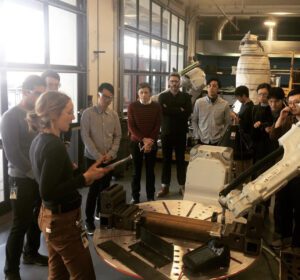Research Conversations with Stefanie Pender
Using a background in art and design to become an expert roboticist
While her path to Autodesk might be unconventional, Stefanie Pender, Senior Shop Supervisor at the Boston Technology Center, brings a wealth of experience in digitizing analog craft processes to fabrication technologies within the Research organization. In her efforts to master glass making, she worked “like a machine,” spending years perfecting hands-on processes in glassblowing, casting, and cutting. When she discovered how CNC technologies could augment her skillset, she pivoted to exploring how technology and digital fabrication is used in manufacturing. She still relies heavily on her background in material and process as she explores the possibilities with robotics and is interested in helping other hands-on makers augment their craft with automation. For the past five years, she has focused her efforts to support a range of robotics projects for Autodesk, our customers, and our residents.
Talk about your role at Autodesk.
While my title is supervisor, my role rarely is supervision. I work hands-on with our research teams, residents, and customers. I support internal and external projects with a focus on robotics. I assist with integration, programming and training using robots. My goal is to make robotics less intimidating and to democratize technology so that it is accessible to everyone, regardless of background and experience.

What’s your favorite thing about working at Autodesk?
I don’t think I would ever meet the group of people I work with other than in a space like this. I love working with a range of professionals from manual machinists and welders to PhDs in computer science. I like to connect with people from diverse backgrounds. I appreciate that the Technology Centers are a safe place for people to learn, fail, and not be afraid to ask questions. There is a feeling of belonging here.
I also value the core of Autodesk’s mission of making a better world and using technology to create a more sustainable, equitable world. We’re not going to stop making things; however, we need to make them smarter.
How does Autodesk use robots?
Most of the robots we have here have six axes and they are the type of industrial robots typical of manufacturing spaces, like in a factory where they’re building cars. They’re ubiquitous, they’ve been around for a while, and are prevalent throughout various industries. We don’t have to develop our own hardware or build our own robots. These are a ready-to-use tool we can put any end effector on and use in a variety of ways. A robot can be a 3D printer, welder, milling machine, and can be used for hundreds of applications.
What are some examples of projects you’ve worked on using robots?
In 2019, AI SpaceFactory participated in NASA’s 3D-Printed Habitat Challenge. Before joining the Outsight Network, no one on the AI SpaceFactory team had ever touched a robot. They were trained by our team and eventually won the $500,000 grand prize.
Last year I worked on a project with Dar, a large conglomerate engineering and design firm, to print a five-meter pedestrian bridge. We used almost every piece of equipment in the shop, including metal fabrication tools, the waterjet, 3D printers, wood working tools, powder coater, and precision machining tools. I supported the project by helping to design and set up the work cells, integrating the safety systems, and assisting programming the robot and sensors. It was a massive team effort and a huge learning opportunity for us as we work towards our goal of fully autonomous printing for construction.
What are some unique projects involving robots that you’ve worked on?
We’ve done some really bizarre things with robots. We’ve tested knives on cutting boards, we flipped a giant pancake with a YouTube star, we used a circular saw on a robot for a ribbon cutting during our opening. There is no limit to what we are asked to do!
When she’s not exploring new opportunities for robotics and teaching others how to do the same, Stefanie enjoys hanging out with her two dogs, practicing yoga, and gardening.
Get in touch
Have we piqued your interest? Get in touch if you’d like to learn more about Autodesk Research, our projects, people, and potential collaboration opportunities
Contact us